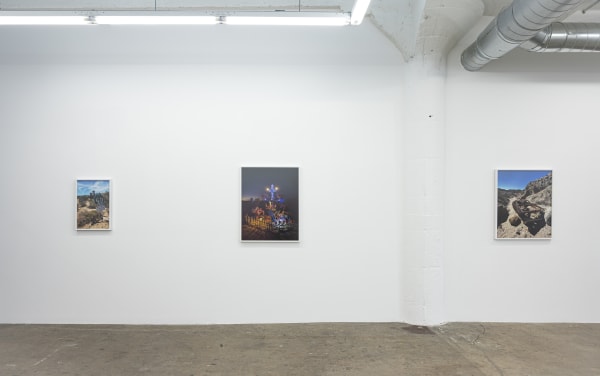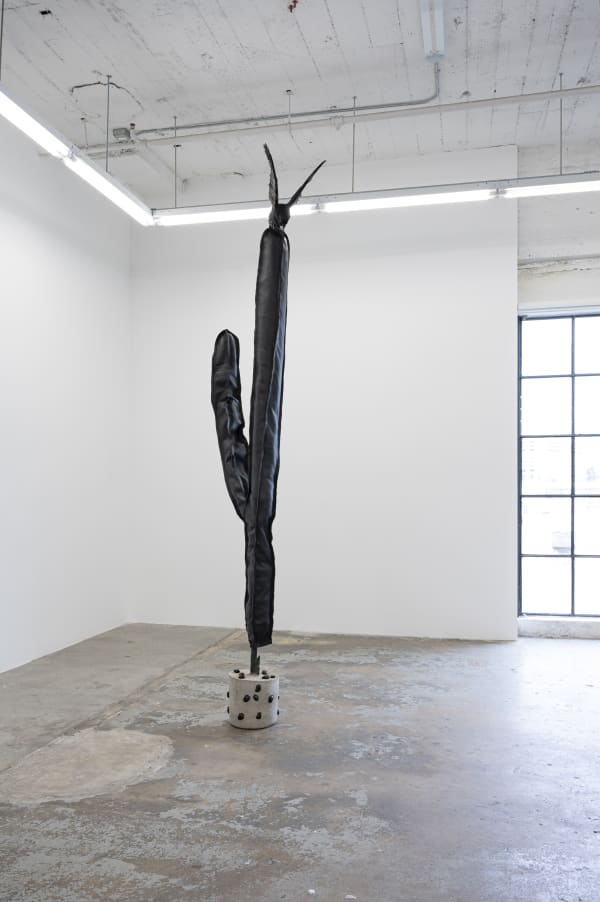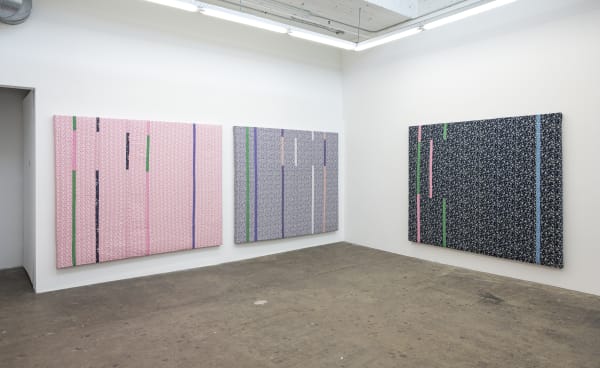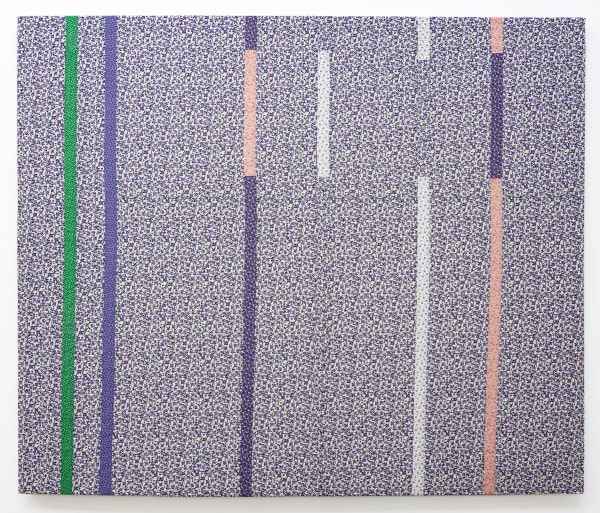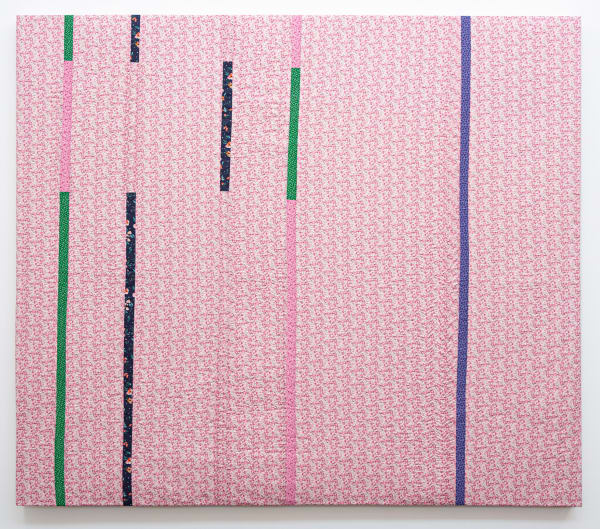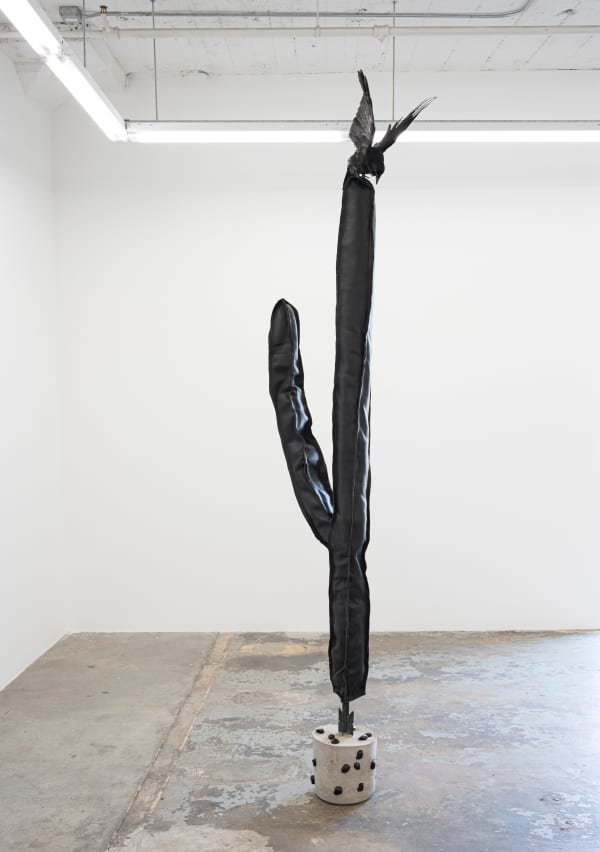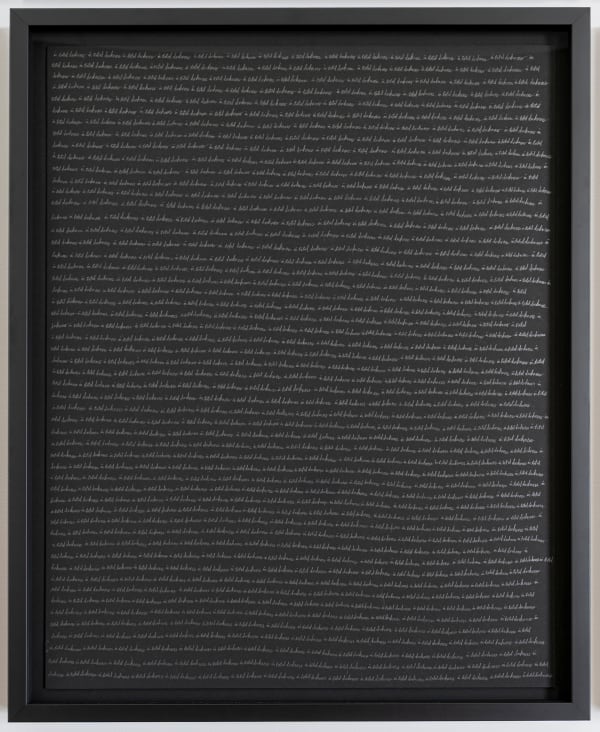Ray Anthony Barrett : ...of frontiers and phantoms
“The American realizes that ‘Progress is God.’ The destiny of the American people is to subdue the continent—to rush over this vast field to the Pacific Ocean... to change darkness into light and confirm the destiny of the human race... Divine task! Immortal mission!”
—William Gilpin (1813-1894), explorer, land speculator, politician, and writer
Wilding Cran Gallery is pleased to present ...of frontiers and phantoms, an exhibition of quilts, photographs, sculptures, and drawings by Ray Anthony Barrett that deepens his ongoing inquiry into the poetics of the western landscape, the mythology of Manifest Destiny, and the interrelated issues of power, capitalism, and white settler colonialism.
Expanding upon his investigation of the relationship between commerce and the American imperial project, Barrett has constructed quilts with materials inextricably linked to the economic history of the United States: calico, cotton, and denim. The near-monochrome works invoke color field painting while vertical bands of fabric in contrasting hues reflect an engagement with syncopation, the sudden interruption of expected patterning present in some African textiles and musical traditions.
Sculptural works further explore the frontier as both a physical and conceptual space. In Shell Company (2021), a shell cradling a cluster of wampum with a ball of 24-karat gold at its centre rests atop a piece of green felt reminiscent of a casino table, underscoring the gambling spirit that characterizes established narratives of land speculation. Perched upon a pedestal made of railroad ties, Buffalo Soldier (2022) offers a conceptualization of the railroad as a signifier of both westward
expansion and “order” as defined in an industrialized context.
In a critique of existing norms of intelligibility, Barrett has created drawings based on Darby English’s How to See a Work of Art in Total Darkness that repeat the words “in total darkness” hundreds of times in graphite on black paper. The arrangement of the text allows one to read it along both the X and Y axes, conjuring the rationality of the modernist grid. The drawings also subvert the convention of black mark-making on a white surface, calling into question the dubious colonial logic of bringing the “light” of reason to “dark” and “uncivilized” communities.
Through this body of work, Barrett contends that subduing the continent has been a prolonged act of hubris. Our divine tasks are to reject the false binary of man versus nature and to reorganize our personal and collective destinies around our ecological interdependence.
-
 Ray Anthony BarrettShell Company, 2021Clam shell, wampum, 24 karat gold, plexiglass, felt, plywood295 1/2 x 14 x 14 inches
Ray Anthony BarrettShell Company, 2021Clam shell, wampum, 24 karat gold, plexiglass, felt, plywood295 1/2 x 14 x 14 inches
750.6 x 35.6 x 35.6 cm. -
 Ray Anthony BarrettDeath Valley Superbloom Quilt, Navy no. 1, 2022Stretched quilt, calico, cotton, denim72 x 84 inches
Ray Anthony BarrettDeath Valley Superbloom Quilt, Navy no. 1, 2022Stretched quilt, calico, cotton, denim72 x 84 inches
182.9 x 213.4 cm. -
 Ray Anthony BarrettDeath Valley Superbloom Quilt, Lavender no. 1, 2022Stretched quilt, calico, cotton, denim72 x 84 inches
Ray Anthony BarrettDeath Valley Superbloom Quilt, Lavender no. 1, 2022Stretched quilt, calico, cotton, denim72 x 84 inches
182.9 x 213.4 cm. -
 Ray Anthony BarrettDeath Valley Superbloom Quilt, Pink no. 1, 2022Stretched quilt, calico, cotton, denim72 x 84 inches
Ray Anthony BarrettDeath Valley Superbloom Quilt, Pink no. 1, 2022Stretched quilt, calico, cotton, denim72 x 84 inches
182.9 x 213.4 cm. -
 Ray Anthony BarrettDeath Valley Superbloom Quilt, Orange no. 1, 2022Stretched quilt, calico, cotton, denim72 x 84 inches
Ray Anthony BarrettDeath Valley Superbloom Quilt, Orange no. 1, 2022Stretched quilt, calico, cotton, denim72 x 84 inches
182.9 x 213.4 cm. -
 Ray Anthony BarrettCul-de-sac, 2021C-type print36 x 30 in. 91.44 x 76.20 cm.Edition 1 of 3 (#1/3)
Ray Anthony BarrettCul-de-sac, 2021C-type print36 x 30 in. 91.44 x 76.20 cm.Edition 1 of 3 (#1/3) -
 Ray Anthony BarrettSpace Heaters, 2021C-print on dibond40 x 53 in. 101.60 x 134.62 cm.
Ray Anthony BarrettSpace Heaters, 2021C-print on dibond40 x 53 in. 101.60 x 134.62 cm. -
 Ray Anthony BarrettBuffalo Soldier, 2022Bronze, buffalo fur, wood, cotton gingham, denim57 x 13 x 10 inches
Ray Anthony BarrettBuffalo Soldier, 2022Bronze, buffalo fur, wood, cotton gingham, denim57 x 13 x 10 inches
144.8 x 33 x 25.4 cm.
(quilt: 46 x 49½ in., 116.84 x 125.73 cm)
-
 Ray Anthony BarrettMemento Mori, 2021Sheep skull11 x 8¼ x 5 inches 27.94 x 20.96 x 12.70 cm.
Ray Anthony BarrettMemento Mori, 2021Sheep skull11 x 8¼ x 5 inches 27.94 x 20.96 x 12.70 cm. -
 Ray Anthony BarrettRoost, 2022Leather, steel, cement, tourmaline, taxidermy crow123 x 26 x 13 inches 312.42 x 66.04 x 33.02 cm.
Ray Anthony BarrettRoost, 2022Leather, steel, cement, tourmaline, taxidermy crow123 x 26 x 13 inches 312.42 x 66.04 x 33.02 cm. -
 Ray Anthony BarrettA Mile To Mecca, 2021C-type print36 x 30 in. 91.44 x 76.20 cm.Edition 1 of 3 (#1/3)
Ray Anthony BarrettA Mile To Mecca, 2021C-type print36 x 30 in. 91.44 x 76.20 cm.Edition 1 of 3 (#1/3) -
 Ray Anthony BarrettForager, 2021C-type print16 x 20 in. 40.64 x 50.80 cm.Edition 1 of 3 (#1/3)
Ray Anthony BarrettForager, 2021C-type print16 x 20 in. 40.64 x 50.80 cm.Edition 1 of 3 (#1/3) -
 Ray Anthony BarrettGO, AWAY, 2021C-type print24 x 16 in. 60.96 x 40.64 cm.Edition 2 of 3 (#2/3)
Ray Anthony BarrettGO, AWAY, 2021C-type print24 x 16 in. 60.96 x 40.64 cm.Edition 2 of 3 (#2/3) -
 Ray Anthony BarrettIn Total Darkness no. 1, 2022Graphite on paper24 x 18 in. 60.96 x 45.72 cm.
Ray Anthony BarrettIn Total Darkness no. 1, 2022Graphite on paper24 x 18 in. 60.96 x 45.72 cm. -
 Ray Anthony BarrettChopping Block, 2021C-type print14 x 11 in. 35.56 x 27.94 cm.Edition 1 of 3 (#1/3)
Ray Anthony BarrettChopping Block, 2021C-type print14 x 11 in. 35.56 x 27.94 cm.Edition 1 of 3 (#1/3)







